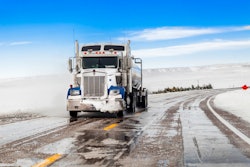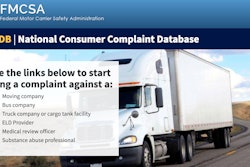The federal electronic logging device (ELD) mandate in Canada has been in effect now for a year, though it has not been fully adopted at the provincial level. While the U.S. has had an ELD mandate since 2018, regulations are regularly changing, making compliance a challenge – even more so for drivers who cross the U.S./Canadian border, working with two sets of regulations.
Solera, which provides risk management and asset protection software, recently hosted an ELD fireside chat webinar with its regulatory compliance experts to share details on the most recent regulations implemented by the Federal Motor Carrier Safety Administration (FMCSA); roadside inspection protocols for drivers; the U.S. vs. Canadian ELD certification process; and how CSA Safety scores can be impacted.
Unidentified driving
During the webinar, unidentified driving was a hot topic among attendees, and Florence Dougherty, director of product responsible for driving digital innovation and transformation to Solera’s Omnitracs, noted the regulation around it as one of the biggest and most impactful changes to fleets.
According to the FMCSA website, a driver can operate within the 150-air mile radius without logging into the ELD, and then log into the ELD once the vehicle reaches that limit. Driving time within that radius will be identified on the ELD as "unidentified driving" time, which the driver must have an exemption for.
Dougherty said the FMCSA previously offered some flexibility around unidentified driving, allowing for on-duty yard move and off-duty personal conveyance classifications.
“Fleets loved it,” she said, because it gave them a lot more flexibility in adjudicating the unidentified driving and getting that onto a driver's logs as opposed to annotating it after the fact.
But it became a lot more restrictive in July last year when the FMCSA posted a clarification to an FAQ that explicitly stated that unidentified driving cannot be moved to a driver's logs as on-duty yard move or off-duty personal conveyance. As it's moved to the driver's logs, it has to be denoted and counted as driving, and the only thing vendors can do is put an annotation on that unidentified driving segment.
“What will happen is, because it is driving, it will reflect and count down against the clock availability,” Dougherty said. “eRODS (electronic record of duty status) will be flagged in the system as a potential violation if it triggers that, but the annotation in it would allow the officer then to look at it and say it's not a violation because they are using yard move or personal conveyance.”
All unidentified driving needs to be either assigned to a driver, or it needs to be noted why it doesn't belong with the driver.
“That would be things like if you have a technician that's doing a road test or something like that. That would be something that would be notated for unidentified driving because it doesn't belong to a driver in your fleet,” she added.
“Gotchas”
There are multiple areas where regulations can catch drivers and fleets off guard and result in a violation, Dougherty said. That’s especially true around those unidentified driving categories: personal conveyance and yard moves.
Dougherty said both yard move and personal conveyance are optional; they are not a requirement in the ELD, although both Canadian and U.S. ELD regulations do provide for them. It is up to the fleet, she said, to authorize or allow a driver to use yard move or personal conveyance.
“If they do allow it to be used, then there are some things to kind of watch out for be mindful of,” she said.
The biggest “gotcha” with yard moves is the definition of what a yard is, Dougherty said. A yard is defined as having no public access. For example, a driver can’t move a vehicle around a Walmart parking lot and have it be considered a yard move because it has public access to the docks. But if it’s a distribution center or another place that doesn’t have public access and meets the other definitions of what a yard is, drivers can legally use the yard move classification.
“That’s something to be aware of and watch out for because a lot of those, if an officer sees yard move in inappropriate places, a driver could be flagged for falsification of logs,” Dougherty said.
Even more challenging is personal conveyance.
She said it’s more challenging because the FMCSA allows for the use of personal conveyance for a driver to get to a safe parking spot to address the parking shortages prevalent in the U.S. Because of that, personal conveyance can and often is misused.
“That doesn't mean it's carte blanche to use it to take your load two hours down the road or even a half hour down the road to Love’s where you want to do your parking versus pulling into a parking lot or other place that allows for truck parking that would be a safe spot,” Dougherty said. “And the other thing to remember is the closest safe parking spot might be two miles behind you; that's where you should go, not continuing down the road. It's pretty easy for officers to spot those kinds of things in logs. So that's probably the biggest falsification of logs that get triggered at roadside inspections around personal conveyance because drivers are trying to use this to actually just keep going.”
Roadside inspections
Dougherty said there are some other concerns for drivers when they hit a roadside inspection. A big one is knowing how to do an eRODS transfer as officers can and will cite drivers for failure to transfer eRODS, which carries three CSA points, impacting a fleets score.
“I think the probably the most critical thing for roadside inspectors is ensuring that drivers understand and know how to readily do a data transfer in Canada or an eRODS transfer in the U.S.,” she said. “That's the first thing that officers are going to ask for because with the ELDs, they have prescribed outputs and they have standardized what officers would be looking at across any ELD vendor, so it makes it easier for the officers because they know where to find things from an eRODS perspective in the U.S. in particular.”
Dougherty said drivers should have on hand and be able to provide immediately to an officer all of the things that are needed in their cab cards, which may be electronic. She also advised to place the ELD in inspector mode if the vendor used offers that feature to make things easier on the officer.
U.S. vs. Canadian ELDs
One difference between the two ELD mandates is how eRODS transfers are performed. In the U.S., the FMCSA built a website that officers log into where all eRODS are transferred. Canada did not build that system and instead opted to email transfer files to the officer for data privacy, better protecting drivers and fleets, Dougherty said. She said the officers have to register with the system to receive and view the data transfer file; it can't be emailed to just anybody.
But that’s not the biggest difference between Canadian and U.S. ELDs.
Dougherty said one is that Canada requires third-party certification. This has led to the FMCSA to crack down on ELD vendors in the U.S. and has even resulted in some providers being delisted, she said. FMCSA has even released some Requests for Comment on whether there should be a change in the U.S. for ELD certification standards.
“We'll have to see how that plays out,” Dougherty said.
Otherwise, she said the U.S. and Canada’s technical standards are pretty harmonious, but there are a few things that are a little bit different in Canada.
Canada introduced some operating zone changes as well as regulations surrounding the recording of specific events.
“The Canadian ELD does prescribe and require that the ELD device warn a driver when they are approaching a violation. Within 30 minutes, they actually have to not only pop up a warning to the driver but also tell the driver which regulation they're close to violation time for,” she said. “In the U.S., the ELD technical standards do not prescribe anything around providing clocks or countdowns or warnings. A lot of the ELD vendors go ahead and provide that because it just makes good sense to provide that information to the drivers, but it isn’t required.”
Another big difference is the number of things that are assessed in the hours-of-service regulations. There are four things that are assessed for hours of service in the U.S., but there are somewhere around 17 different items that have to be tracked and the driver needs to be warned about in Canada, which could be why warnings are required, Dougherty said.
“Another thing to pay attention to – this is more on the hours-of-service regulations as opposed to the ELD’s technical standards - in the U.S., using a sleeper berth split allows the combination of off-duty time in the shorter portion of the split with the longer portion in the sleeper berth,” she added. “In Canada, both portions have to be in the sleeper berth.”
Because of these differences, she offered some best practices when crossing the border.
“The biggest one to talk about is making sure that the driver stops and looks at the clock and understands what hours he'll have available once he crosses the border,” Dougherty said. “A driver should be evaluated against the regulations of the jurisdiction that they're in at the time the roadside inspection happens, which means if they transfer in the middle of the day, they need to be mindful because they might have 30 hours of driving in Canada, which is fine as long as they stay in Canada, but as soon as they've crossed into the U.S. they only have 11 hours …”
Drivers may need to stop and take the reset before they drive across the border.
“Don't just blindly think that because you were okay in one place and do go over that there's some grace period or some amount of time that you'll be allowed and not trigger (a violation) when you cross the border,” she added.












